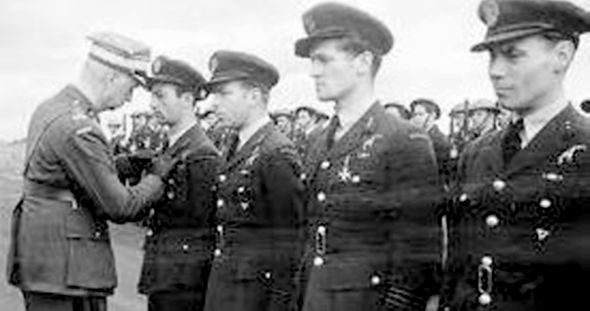

Tadeusz SAWICZ
Pilot & Wing Commander in the Polish Air Force in the UK
Born: 13 February, 1914, in Warsaw.
Died: 19 October, 2011, in Toronto, aged 97
In 1934, Sawicz joined the Air Force College in Deblin, and was commissioned as a fighter pilot into the fledgling Polish air force in 1036. At the start of World War II in 1939, he fought in Poland's air defence against the invading German Nazis. When Poland’s fate was sealed by the Soviet Union’s invasion from the east on 17 September, 1939, all surviving air and ground crew were evacuated to Rumania. The Polish air force reformed in France. Sawicz underwent conversion training, on a modern though indifferent French fighter. When France capitulated he flew to North Africa from where he made it to Britain by sea. He yet again underwent conversion training, this time on a superb plane, the Hurricane.
Tadeusz Sawicz was one of the 145 Polish pilots who had fought, either in Polish squadrons or in RAF squadrons, in the Battle of Britain. Air Chief Marshal Sir Hugh Dowding, Commander in Chief of Fighter Command during the battle, said: “Had it not been for the magnificent material contributed by the Polish squadrons and their unsurpassed gallantry, I hesitate to say that the outcome of the battle would have been the same.”
In October 1940, he was assigned to No 303 (Kosciuszko) Squadron for the final stage of the Battle of Britain. This squadron was to prove to be the top scorer in the battle. He was then posted to No 316 (City of Warsaw) Squadron. In June, 1942 he became an instructor with 58 Operational Training Unit at RAF Grangemouth.
Here pilots were put through their final paces before being sent to operational squadrons. Amongst other skills, trainees were taught dog fighting, aerobatics and low-level flying. They came from Britain, Canada, Rhodesia and New Zealand and from the occupied countries of Europe. The instructors were all, like Sawicz, already well experienced in air combat, several being Battle of Britain veterans.
Training was dangerous, as is attested by the Grangemouth Memorial, inscribed with the names of 78 pilots, 12 of whom were Polish, killed while serving with 58 OTU or with other RAF Grangemouth-based units. While some of the fatalities were due to mechanical failures, others were the result of mid-air collisions or crashes due to adverse weather conditions.
A number of duty moves followed. One was a stint in 1944 with the American Air Force’s 61st Fighter Squadron. Flying Thunderbolts, he flew sorties on the approach to D-Day. Back with the Polish Air Force, Sawicz was put in command of No 138 Wing RAF, which comprised three Polish fighter squadrons, until the end of the war. The wing was in frequent action during the liberation of north-west Europe.
Sawicz served in the Polish Air Force in Britain from the 1940 Battle of Britain until 1947, and is credited with shooting down three German aircraft. He was awarded Poland's highest military order, the Virtuti Militari, as well as the British, American and Dutch Distinguished Flying Crosses. In 2006, he was awarded the honorary distinction of brigadier general by Poland’s late President, Lech Kaczynski.
Sawicz chose to remain in exile rather than return to a now Soviet-dominated Poland. He ended the war as a wing commander, spent some years in the UK before emigrating to Canada in 1957, where he worked for a number of aviation companies.
He died on 19 October 2011 in Toronto, and his ashes were repatriated to Warsaw, where he was given a full state funeral. A contingent from the Royal Air Force, joined by the British Ambassador to Poland and the Polish Defence Minister Tomasz Siemoniak, welcomed General Sawicz’s ashes back to Poland. After lying in state at Warsaw’s Field Cathedral of the Polish Army, General Sawicz was given a full state funeral at the Powaski military cemetery, attended by his step-daughter Anna and widow Jadwiga Sawicz.



